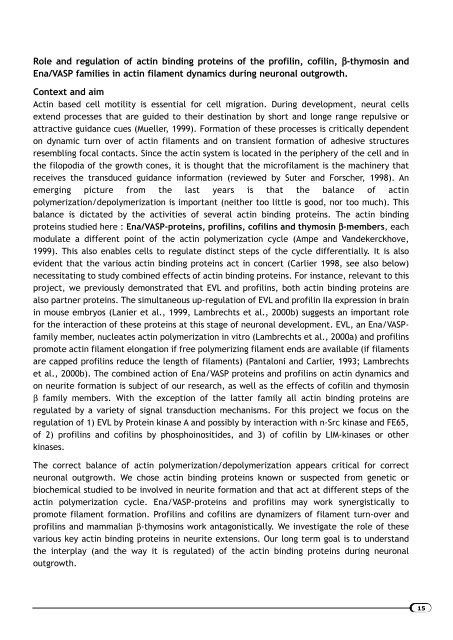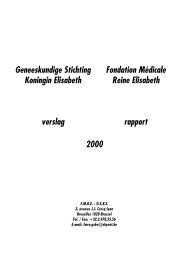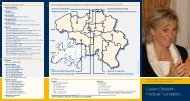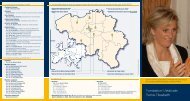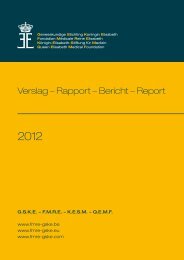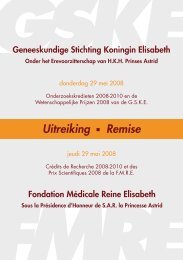Geneeskundige Stichting Koningin Elisabeth verslag - GSKE - FMRE
Geneeskundige Stichting Koningin Elisabeth verslag - GSKE - FMRE
Geneeskundige Stichting Koningin Elisabeth verslag - GSKE - FMRE
You also want an ePaper? Increase the reach of your titles
YUMPU automatically turns print PDFs into web optimized ePapers that Google loves.
Role and regulation of actin binding proteins of the profilin, cofilin, β-thymosin and<br />
Ena/VASP families in actin filament dynamics during neuronal outgrowth.<br />
Context and aim<br />
Actin based cell motility is essential for cell migration. During development, neural cells<br />
extend processes that are guided to their destination by short and longe range repulsive or<br />
attractive guidance cues (Mueller, 1999). Formation of these processes is critically dependent<br />
on dynamic turn over of actin filaments and on transient formation of adhesive structures<br />
resembling focal contacts. Since the actin system is located in the periphery of the cell and in<br />
the filopodia of the growth cones, it is thought that the microfilament is the machinery that<br />
receives the transduced guidance information (reviewed by Suter and Forscher, 1998). An<br />
emerging picture from the last years is that the balance of actin<br />
polymerization/depolymerization is important (neither too little is good, nor too much). This<br />
balance is dictated by the activities of several actin binding proteins. The actin binding<br />
proteins studied here : Ena/VASP-proteins, profilins, cofilins and thymosin β-members, each<br />
modulate a different point of the actin polymerization cycle (Ampe and Vandekerckhove,<br />
1999). This also enables cells to regulate distinct steps of the cycle differentially. It is also<br />
evident that the various actin binding proteins act in concert (Carlier 1998, see also below)<br />
necessitating to study combined effects of actin binding proteins. For instance, relevant to this<br />
project, we previously demonstrated that EVL and profilins, both actin binding proteins are<br />
also partner proteins. The simultaneous up-regulation of EVL and profilin IIa expression in brain<br />
in mouse embryos (Lanier et al., 1999, Lambrechts et al., 2000b) suggests an important role<br />
for the interaction of these proteins at this stage of neuronal development. EVL, an Ena/VASPfamily<br />
member, nucleates actin polymerization in vitro (Lambrechts et al., 2000a) and profilins<br />
promote actin filament elongation if free polymerizing filament ends are available (if filaments<br />
are capped profilins reduce the length of filaments) (Pantaloni and Carlier, 1993; Lambrechts<br />
et al., 2000b). The combined action of Ena/VASP proteins and profilins on actin dynamics and<br />
on neurite formation is subject of our research, as well as the effects of cofilin and thymosin<br />
β family members. With the exception of the latter family all actin binding proteins are<br />
regulated by a variety of signal transduction mechanisms. For this project we focus on the<br />
regulation of 1) EVL by Protein kinase A and possibly by interaction with n-Src kinase and FE65,<br />
of 2) profilins and cofilins by phosphoinositides, and 3) of cofilin by LIM-kinases or other<br />
kinases.<br />
The correct balance of actin polymerization/depolymerization appears critical for correct<br />
neuronal outgrowth. We chose actin binding proteins known or suspected from genetic or<br />
biochemical studied to be involved in neurite formation and that act at different steps of the<br />
actin polymerization cycle. Ena/VASP-proteins and profilins may work synergistically to<br />
promote filament formation. Profilins and cofilins are dynamizers of filament turn-over and<br />
profilins and mammalian β-thymosins work antagonistically. We investigate the role of these<br />
various key actin binding proteins in neurite extensions. Our long term goal is to understand<br />
the interplay (and the way it is regulated) of the actin binding proteins during neuronal<br />
outgrowth.<br />
15


